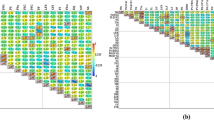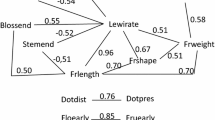Abstract
Forty-nine morpho-nut characters were measured over the period 1994–1996 to study the relationships of 23 accessions of chestnut representing five lines of known chestnut species and 18 lines of New Zealand (NZ) chestnut selections. The study was prompted by the lack of knowledge of the parentage of NZ chestnut selections. These are presumed to be hybrids resulting from uncontrolled open pollination of the introduced chestnut species in NZ, most especially, Castanea sativa (European species) and C. crenata (Japanese species). Data were analysed by Principal Component Analysis (PCA) and the Unweighted Pair Group Mean (UPGMA) method of cluster analysis. Thirty-one characters out of the 49 used in the study accounted for the major variations among accessions. Results from both methods agreed and showed the separation of the chestnut species and NZ selections along geographic lines. The South Island selections were found to be mostly C. sativa-like while the North Island selections were mostly C. crenata-like. The discrimination between groups and description of differences between groups were more strongly marked from the PCA than in the UPGMA cluster analysis.
Similar content being viewed by others
References
Ahmad, M. & D.L. McNeil, 1996. Comparison of crossability, RAPD, SDS-PAGE and morphological markers in revealing genetic relationships within and among Lens species. Theor Appl Genet 93: 788–793.
Cross, R.J., 1990. Assessment of IBPGR morphological descriptors in determining pattern within crop germplasm collection. PhD Thesis. Lincoln University, Canterbury, NZ.
Goldsbrough, G., 1990. A beginner's guide to Chestnut growing. Hilton press. 40 pp.
Hanboonsong, Y., 1994. A comparative phenetic and cladistic analysis of the genus Holcapsis Chaudoir (Coleoptera: Carabidae). PhD Thesis. Lincoln University, Canterbury, NZ.
Howat, J.I., 1992. History and structure of the NZ chestnut industry. In: Proceedings of the NZ Chestnut Conference, Hamilton, New Zealand, pp. 1–10. New Zealand Chestnut Council Inc.
Howat, J.I. & M.J. Kestle, 1992. Cultivar evaluation. In: Proceedings of the NZ Chestnut Conference, Hamilton, NZ, pp. 118–142. NZ Chestnut Council Inc.
Haynes, R.A., 1961. Genetic and cytological studies in the genus Castanea. Doctoral Dissertation, Yale University, New Haven, Connecticut.
Jaynes, R.A., 1963. Biparental determination of nut characters in Castanea. J Heredity 54: 84–88.
Klinac, D.J. & J.F. Lelieveld, 1992a. Effect of pollen source on nut quality and incidence of multiembryonic nuts in chestnuts. Report to the New Zealand Chestnut Council. 8 pp.
Klinac, D.J. & J.F. Lelieveld, 1992b. Chestnut pollination. In: Proceedings of the New Zealand Chestnut Conference, Hamilton, New Zealand, pp. 10–23. New Zealand Chestnut Council Inc.
Klinac, D.J. & J.F. Lelieveld, 1993. Chestnut pollination in the Waikato. Report to the New Zealand Chestnut Council. 11 pp.
Kolinac, D.J., J.F. Lelieveld & T.H. Dinning, 1994. Chestnut pollination and production in the Waikato. Report to the NZ Chestnut Council. 11 pp.
Manly, B.F.J., 1986. Multivariate statistical methods: A Primer. Chapman and Hall. 159 pp.
McKay, J.W. & H.L. Crane, 1939. The immediate effect of pollen on the fruit of the chestnut. Proc Amer Soc Hort Sci 36: 293–298.
Oraguzie, N.C., D. McNeil & D. Klinac, 1996a. Characterisation of genetic identities and relationships of Castanea species and F1 interspecific hybrids via a random amplified polymorphic DNA assay. Abstract of the NZ Society of Horticultural Science/NZ Society of Plant Physiologists/NZ Institute of Agronomy Convention held at Ruakura Research Centre, Hamilton, New Zealand, on August 26–29, p. 629.
Oraguzie, N.C., D. McNeil & D. Klinac, 1996b. Species relationships in New Zealand chestnut selections as determined by random amplified polymorphic DNA (RAPD) markers. Paper presented to New Zealand Chestnut Council Inc., Hamilton, New Zealand, on August 27, 1996.
Oraguzie, N.C., D. McNeil, D. Klinac & R.D. Knowles, 1996c. Assessment of relationships of chestnut species, F1 hybrids and NZ chestnut selections using leaf characters. Paper presented to New Zealand Chestnut Council Inc., Hamilton, New Zealand, on August 27, 1996.
Oraguzie, N.C., D.L. McNeil, D. Klinac, A.G. Fautrier & A.M. Paterson, 1997. Genetic relationships in chestnut species and parentage determination of the New Zealand chestnut selections using RAPD markers. Genome (submitted).
Rutter, P.A., G. Miller & J.A. Payne, 1990. Chestnuts (Castanea). Acta Horticulturae 290: 761–768.
SAS Institute Inc., 1986. SAS User's Guide: Statistics Version 6 Edition. SAS Institute Inc., Cary, NC 27511–800.
Author information
Authors and Affiliations
Rights and permissions
About this article
Cite this article
Oraguzie, N.C., McNeil, D.L., Klinac, D.J. et al. Relationships of chestnut species and New Zealand chestnut selections using morpho-nut characters. Euphytica 99, 27–33 (1998). https://doi.org/10.1023/A:1018356931080
Issue Date:
DOI: https://doi.org/10.1023/A:1018356931080




